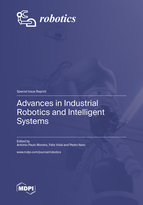Advances in Industrial Robotics and Intelligent Systems
A special issue of Robotics (ISSN 2218-6581). This special issue belongs to the section "Industrial Robots and Automation".
Deadline for manuscript submissions: closed (31 May 2022) | Viewed by 43108
Special Issue Editors
Interests: control; automation; industrial manipulators; mobile robotics
Special Issues, Collections and Topics in MDPI journals
Interests: robotics for agile manufacturing; industry 4.0; collaborative robots; digital manufacturing
Special Issues, Collections and Topics in MDPI journals
Interests: coatings application technology; manufacturing; industrial robotics; AI; pattern recognition
Special Issues, Collections and Topics in MDPI journals
Special Issue Information
Dear Colleagues,
Robotics, automation, control and mechatronics technologies have become essential to developing devices, machines, production lines and other activities that are repetitive, dangerous, difficult to perform and, in general, not suitable for human operators. Robotics and other related topics have seen a fast evolution in industry, services and other application areas. These systems are expected to operate in unstructured, unpredicted environments and deal with high-mix low-volume (HMLV) applications.
This Special Issue aims to disseminate the latest research achievements, ideas and applications of robotics, control and automation, including, but not limited to, the following:
- Fast setup of robotic systems;
- Programming robots based on CAD;
- Programming manipulators by demonstration;
- Autoadaptive and intelligent robotic cells;
- Transportable manipulators;
- Autonomous mobile manipulators;
- Mobile robot fleet management;
- Advanced sensing and perception;
- Motion control;
- Grasp planning;
- Trajectory planning in challenging environments;
- Applications of robots and mechatronics systems.
You may choose our Joint Special Issue in Applied Sciences.
Prof. Dr. António Paulo Moreira
Prof. Dr. Pedro Neto
Dr. Félix Vilariño
Guest Editors
Manuscript Submission Information
Manuscripts should be submitted online at www.mdpi.com by registering and logging in to this website. Once you are registered, click here to go to the submission form. Manuscripts can be submitted until the deadline. All submissions that pass pre-check are peer-reviewed. Accepted papers will be published continuously in the journal (as soon as accepted) and will be listed together on the special issue website. Research articles, review articles as well as short communications are invited. For planned papers, a title and short abstract (about 100 words) can be sent to the Editorial Office for announcement on this website.
Submitted manuscripts should not have been published previously, nor be under consideration for publication elsewhere (except conference proceedings papers). All manuscripts are thoroughly refereed through a single-blind peer-review process. A guide for authors and other relevant information for submission of manuscripts is available on the Instructions for Authors page. Robotics is an international peer-reviewed open access monthly journal published by MDPI.
Please visit the Instructions for Authors page before submitting a manuscript. The Article Processing Charge (APC) for publication in this open access journal is 1800 CHF (Swiss Francs). Submitted papers should be well formatted and use good English. Authors may use MDPI's English editing service prior to publication or during author revisions.
Keywords
- robotics
- mechatronics
- sensors
- actuators
- modelling
- simulation
- navigation
- motion planning
- kinematics
- dynamics
- control








